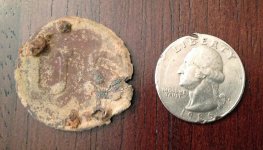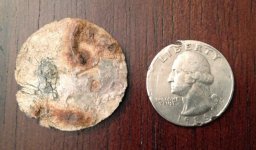McCDig
Silver Member
- Jan 31, 2015
- 3,753
- 9,039
- 🥇 Banner finds
- 1
- Detector(s) used
- Fisher F75
- Primary Interest:
- Metal Detecting
Found this today at a site that has yielded colonial items: buttons, musketballs, later 1700s coins, and a couple buckle fragments.
This item has me stumped.

It distinctly bears the lower-case letters 's' 'n', is thin and somewhat brittle. You see from the pic that in handling out of the ground it began to fragment.
Because of its shape I don't think this was part of something larger.
Ideas?
This item has me stumped.


It distinctly bears the lower-case letters 's' 'n', is thin and somewhat brittle. You see from the pic that in handling out of the ground it began to fragment.
Because of its shape I don't think this was part of something larger.
Ideas?
Amazon Forum Fav 👍
Last edited:














